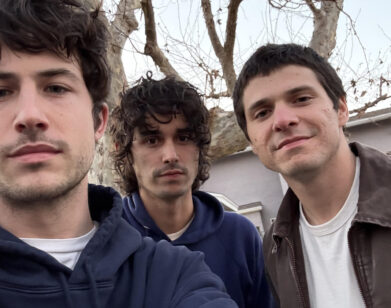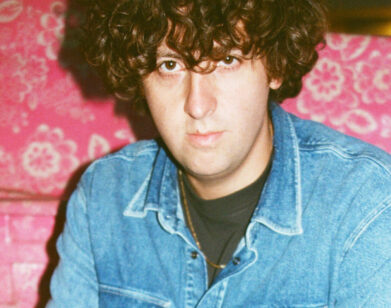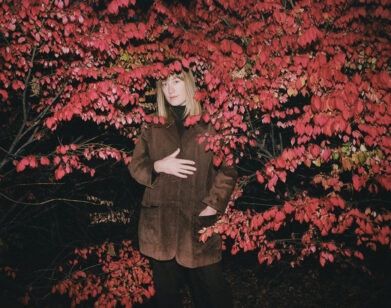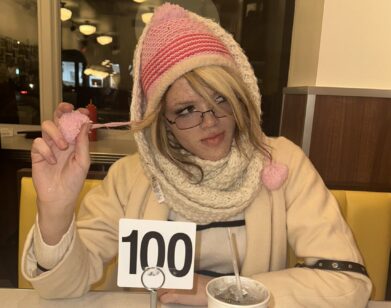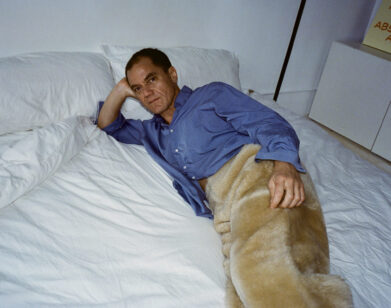Exclusive Song Premiere and Interview: ‘HEIR II,’ Balmorhea
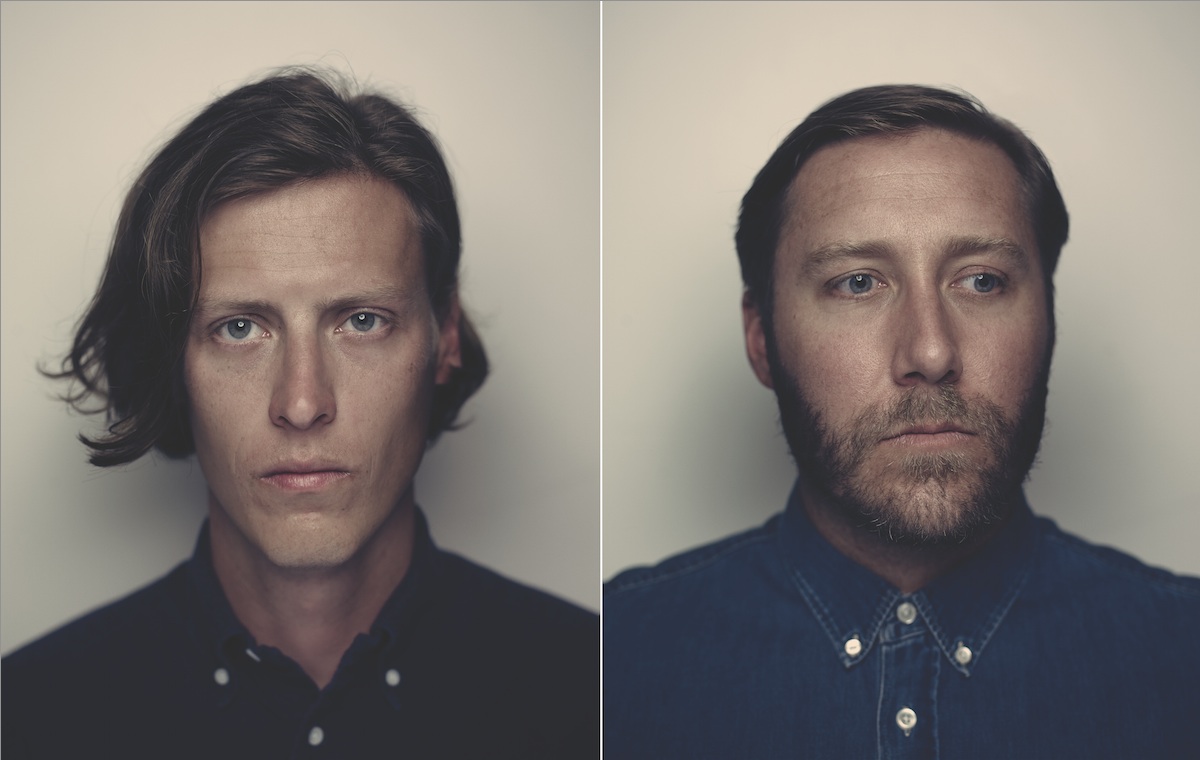
ABOVE: BALMORHEA’S ROB LOWE (LEFT) AND MICHAEL MULLER. PHOTO COURTESY OF MATT RAINWATERS
The enormous nation-within-a-nation of Texas has produced no shortage of fine instrumental groups in recent decades, including most famously Explosions in the Sky and (on the opposite end of the volume spectrum) the ambient duo Stars of the Lid. Beginning in 2006, Austin’s Balmorhea has made its own mark among those prestigious acts, initially as a duo and then as a six-piece ensemble; and eight years later, its founders Rob Lowe and Michael Muller are feeling a little nostalgic. In late October, Western Vinyl will issue a remastered version of the band’s eponymous debut on lush 180g vinyl (it gets a CD and digital re-issue, too) as well as the new HEIR 7-inch. Lowe and Muller will then perform one-off shows as a duo in Austin and Brooklyn before heading to Europe for three weeks. This marks the first time Balmorhea’s fervent European audiences will hear Balmorhea live.
Lowe and Muller aren’t the only Texans feeling nostalgic these days, of course. The influential emo pioneers Mineral resurrected for a still-in-progress reunion tour, giving us an ideal setting to discuss Balmorhea’s present look into the past. Two weeks ago, we met Muller at Union Transfer in Philadelphia, and spent the morning talking over coffee and breakfast at Tela’s. We covered a lot of ground, from the band’s beginnings to its travels in Russia to the evolution of Balmorhea’s sound to the appearance of their work in the Sundance show Rectify and more. We also connected with Lowe via email to get his thoughts on HEIR and how far the band has come in less than a decade.
Enjoy this exclusive premiere of the Balmorhea track “HEIR II” and read our interview with the band below.

RYAN BURLESON: Tell me how you and Rob met and began working on Balmorhea.
MICHAEL MULLER: We met working at a summer camp. I’d just moved to Austin and Rob was in school at the University of Texas. We were acquaintances through the camp, and we eventually had a similar circle of friends in Austin. He was doing solo music and I had a lot of old demos and we realized we had similar taste in music, so we started hanging out. At some point he played a house show by himself and it was amazing. He will say it wasn’t, but it was. He had a midi controller with an acoustic guitar and was generating loops and fluid recordings. It was great. He self-released one EP, Harbinger, under his own name, and then we started playing.
BURLESON: Was the collaboration called Balmorhea at that point?
MULLER: We were just playing for fun at that point. We were having so much fun that we wrote six songs or so, then he made a couple more and I made a couple more, and that became our first record. We didn’t know what we were doing. It was recorded in the fall of 2006 and we pressed it ourselves, 1000 copies on CD.
BURLESON: How did you two get hooked up with Brian at Western Vinyl?
MULLER: I read a review about this guy who performed as Bexar Bexar and it turned out his music sounded amazing. I looked at his MySpace page and it said “Austin,” and I wrote to him just thinking he was a musician. He eventually shared a bill with us and after we played he said, “I run this label. Have you thought about releasing on a label?” And we were like, “Yeah, we don’t really know how to do that.”
BURLESON: When did Balmorhea start touring?
MULLER: We played a lot in Austin when we first started. We’d been talking about our collaboration to friends who were in a band, and they invited us to play a show. At that point we decided we needed to have a name. Balmorhea is this location in West Texas with incredible springs near where Rob grew up. The name had this magical oasis-in-the-desert feel, so we went with it. But, yeah, we started out playing once or twice a month in Austin for the first six months. And then we went on tour in the summer of 2007. We basically went to L.A. and back. Our first show outside Austin was in Albuquerque, then we went up to Boulder, Salt Lake, Reno, San Francisco. San Francisco was the first show we played in a real venue. The whole tour we mostly played coffee shops or co-ops or weird, DIY spots. This is before iPhones. We printed out Google Maps directions. There were a couple of good shows, but some nights there were literally two people. No one knew about us. There was no distribution. It was just Rob and me in a Jeep Cherokee. Then the next year we did another tour of the East coast, and by that time some people knew who we were.
BURLESON: At what point did you two decide to include other musicians and experiment with your original sound?
MULLER: After the self-titled record and the first round of shows, we realized the sound was kind of locked-in. We couldn’t do too much more. At the time we were listening to a lot of music with strings—classical and minimal modern compositions. We had a friend of a friend who played cello, so we asked her if she wanted to play with us. She came over one day and was playing really simple stuff, but it sounded great. Her name was Erin and she eventually played on Rivers Arms. She played our Austin shows, but couldn’t tour due to her job, so we started playing with Nicole Kern. And then Aisha Burns joined. So on our second record, Rivers Arms, we added cello and violin, and my friend Jacob Glenn Levin played electric bass on a few songs. He’s a dear man. After Rivers Arms we decided we need some rhythm, so we added upright bass. So since 2010, since All is Wild, All is Silent, it’s been the same number of people. We’ve had a few different drummers, and with Stranger we added electronic elements.
BURLESON: Were you and Rob intentional about keeping the music instrumental?
MULLER: We had no intention. We were just making what we made, and that’s what it was. On the most recent albums, we thought more about what kind of sounds we wanted to explore. We do use vocals as instruments sometimes, but, I don’t know, I’ve tried to write lyrics before and that just doesn’t come naturally to me, so I veered toward instrumental routes. We’ve never had a master plan. We just take it one release at a time.
BURLESON: Does that suggest you might be open to using vocals in a more traditional way at some point?
MULLER: I have no clue. [laughs] We’ve never done much in the way of collaboration. We’ve had people help on commercial projects. And on Candor / Clamor we hired a young woman who sang opera to sing on one song, which was fun. We had Jesy from Tiny Vipers sing on a few songs, and that was absolutely a dream come true. We love having musicians we know do remixes. We asked Nils [Frahm] to do one for the re-issue and he basically made his own version of the song (“Attesa”), which is nice. That’s the one song we recorded a new version of ourselves too.
BURLESON: In light of our Mineral experience, do you feel like the music you grew up on comes into play with Balmorhea at all?
MULLER: Yeah totally. In ’94 and ’95 I was listening to alternative and grunge, and then punk and hardcore always. And then emo started rearing its head—Archers of Loaf, etc. And that led into, you know, all of the Polyvinyl and Jade Tree stuff. At the same time, I was way into Thrill Jockey and the early Mogwai stuff. The first couple of Mogwai and Tortoise records were responsible for me getting into quieter, instrumental-based music. I taught myself how to play bass by putting on Tortoise records and trying to figure out how to play those songs. In terms of the acoustic stuff, there was a Tortoise side band called Pullman that was super influential. Then there are bands like Six Parts Seven. Those are my main influences in terms of Balmorhea. I think Rob brought more of a classical, composerly influence. I know his dad grew up on a lot of Windham Hill stuff, so you can definitely hear some William Ackerman influences in the acoustic guitar songs, some open tuning stuff. Rob and I overlap on a lot of different influences in that world because my dad listened to some weird New Age stuff here and there too, which I always loved.
BURLESON: There’s a quote in the press release for HEIR that says, “…the band brings everything full circle, returning to the simple structures and melancholic tone that colored their first recordings.” What does it mean to you to be revisiting Balmorhea’s debut and touring as a duo again after years of performing as an ensemble? How did your thinking about those early recordings influence the writing of HEIR?
ROB LOWE: The last time Michael and I toured together as a duo was in August of 2007. We played in a number of coffee shops, my parents’ living room, a musical instrument store, a punk/DIY house, and on a student radio show that probably had no more than five listeners (two of which were our girlfriends listening from the car). So things have changed quite a bit. What made those early performances special was that we were doing it completely for ourselves. We had made this incredibly simple music and cared for it ourselves without having much of an idea about who else might interact with it or care for it. What makes this tour so special is that we get to revisit that early material and reopen it. It is different than anything we have done before and I’m hoping that we can re-engage with the way we were approaching music-making at that time.
As far as HEIR bringing things full circle, I believe that is something the record label identified in the tracks. I can see how the simplicity of these two new songs relates to some of the earlier recordings, but they are also quite different in tone. It seems that each subsequent project we work on gets a bit trickier in that not only should it be something new, but it should add to and expand the other works in the collection. I like thinking about the music Balmorhea has made as being part of one large structure. You can enter it at different points and you might find some sections are quite different than others, but that it all is made to fit together.
MULLER: It’s going to be surreal. We won’t have a sound person on this tour since there’s only seven inputs max. It’s super easy to mix. We’ll only have acoustic and electric guitars, a piano, and a laptop. And we’ll have visuals. There’s an artist from London who’s a friend of ours named Peter Liversidge. He does all the visuals for Low as well. We’re really looking forward to using them.
BURLESON: The Balmorhea song “Bowsprit” plays in the opening credits of the TV show Rectify. How did that come about?
MULLER: We just got an email one day. We didn’t know anything about it, but we knew the name Ray McKinnon, who produces the show. He’s also an actor. They sent us some clips to show us the premise and we agreed to their use of the song. We are really pleased with both the show and how the song works in the opening credits.
BURLESON: Balmorhea’s work has also been featured in other high-profile ways. The Toyota ad which aired during the Super Bowl comes to mind, as well as the spot in ESPN’s 30 for 30. Obviously there are many other examples as well. Have you gotten used to hearing Balmorhea’s work used for this purpose on such a massive scale? Do you guys still get excited when these opportunities come through?
MULLER: I wouldn’t say we’re used to it. I mean, it’s so expensive for us to tour and we don’t sell a lot of records, relatively speaking, so we don’t make much money that way. So having songs used in this way allows us to keep doing what we’re doing. It helps pay for plane tickets when we go on tour, that sort of thing. It’s exciting anytime someone emails us telling us they like our music. That’s still rewarding.
BURLESON: Balmorhea toured in Russia for the first time last year, right? Where else did the band travel that you hadn’t played before?
MULLER: Yeah, we played two shows in Russia and then we played in Istanbul and Mexico City. That was a one-off show produced by this new promotion company that’s made up of really great people. They flew us down and we played one of our biggest shows ever. It was awesome. It was so professional. They created this whole stage set-up with trees and covered the stage in dried leaves.
BURLESON: How did the Russian crowds respond to Balmorhea?
MULLER: Very well. The Moscow show was sold out, or close to it. It was super packed. The St. Petersburg venue was way too big for a band on our scale, but the show was still fun. And we got our best reaction in Kiev. People were going crazy, throwing flowers on stage. It was very surreal. At first I thought we were being mocked or were part of an elaborate prank, but everyone turned out to be really nice. I think there aren’t many bands who travel there, so it seemed like everyone was excited to see an American band.
BURLESON: The release of the reissue and HEIR marks a point of looking back and looking forward. Where does your head go when you think about how much has happened and changed for Balmorhea since 2006? What about when you consider the band’s future?
LOWE: I feel incredibly lucky to have taken what was such a personal project and be able to share it with so many people. All of the touring and performing, and the people we’ve met in the last eight years have exceeded what I could have imagined in 2006. I hope that we can continue adding new pieces to this catalogue. How long it will take for the next one to be formed, I don’t know, but I believe there is more to share.
BALMORHEA WILL PERFORM AT THE GREEN BUILDING IN BROOKLYN ON OCTOBER 28 TO COMMEMORATE THE RE-ISSUE OF BALMORHEA‘S SELF-TITLED DEBUT AND THE HEIR 7-INCH, BOTH OF WHICH ARRIVE IN LATE OCTOBER. FOR MORE ON THE BAND, PLEASE VISIT ITS WEBSITE.

